When I started playing the harp, I worked through Ann Heymann’s book Secrets of the Gaelic Harp (Clairseach, 1988). The first tune that I learned from this book was Mailí Bhán, “fair Molly”.
Ann says (p.50)
This tune occurs three times in Bunting’s manuscripts, and all three state that it was the “first tune learned on the harp”
I think that we can be more precise than that now, using the principles I have developed in my Old Irish Harp Transcription Project.
Quin’s Mailí Bhán
Edward Bunting notated the tune of Mailí Bhán live from the playing of old Irish harper, Patrick Quin. Bunting wrote this transcription into a series of pages which are now upside-down in the back of a tune notebook that was mostly used in Westport in 1802 (see my text transcript of MS4.33.1) In my summary of Bunting’s collecting tours I suggest that this set of pages was written between 1802 and 1805.
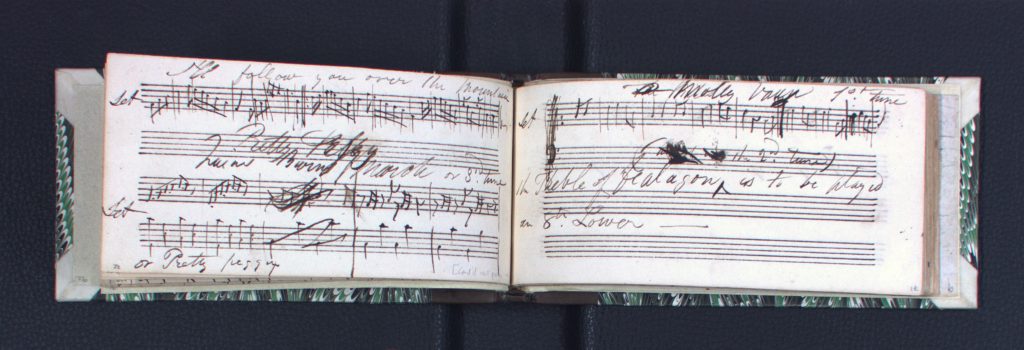
Bunting has written the title “Molly Vann” and he has tagged it “1st tune”. In the past I have transcribed the handwritten phonetic title “Vaun” but I realised that Bunting writes “u” and “n” the same, and “Vann” would make a lot more sense as a phonetic attempt at “Bhán”.
The transcription is pretty clear, with notes and barlines, though it is written one note higher than we expect. The Quin transcriptions in this section of this notebook are all clear, as if Bunting had got better at making live transcriptions since the 1790s. The only reason I am not doing a YouTube demonstration of them is that Sylvia Crawford is currently working on them, especially on the “first tunes”, and she will write more about these Quin transcriptions and will make recordings and video demonstrations as part of her forthcoming method book on old Irish harp playing technique, and her forthcoming in-depth study of Patrick Quin. In the meantime you can read her MA thesis if you want to find out more about her work.
We can follow Quin’s version of Mailí Bhán through Bunting’s later copies and piano arrangements. There is a manuscript piano arrangement in QUB SC MS4.12 (I think the reference is QUB SC MS4.12.2.23), but I don’t know when it might date from. It is titled “Molly vann, or molly veagh O” and is tagged “First tune Learned on the Harp”. The melody, and the title “Molly Vann” and the information about it being the “first tune” all presumably derive from Quin. Is the alternative title “Molly Veagh O” also from Quin, or is this Bunting’s (or someone else’s) incorrect conflation of an unrelated tune title?
Bunting published a piano arrangement derived from the Quin transcription, in his 1809 printed piano book. The tune appears on page 30, with the title “Malli ban – Fair Molly”.
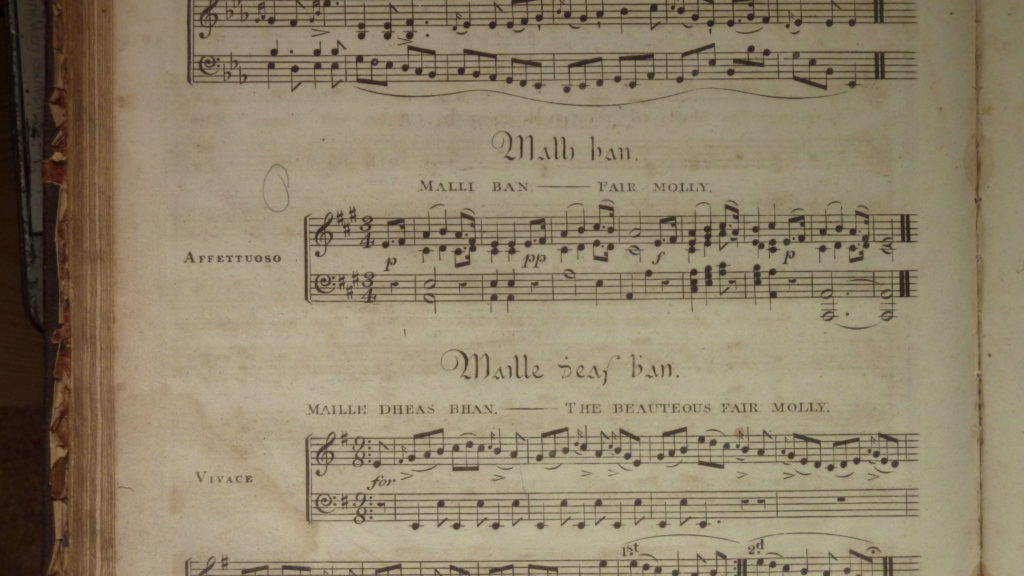
Probably in the late 1830s or even in the early 1840s, Bunting went back to his older publications and added manuscript annotations into his own personal copies (London, British Library Add MS 41508: see Karen Loomis’s paper on this). Against the tune of “Malli ban – Fair Molly” on p.30 of the 1809 book, he writes “Harp Byrne”, and underneath the tune he writes “First tune taught on the harp”. Do we understand that Bunting transcribed a version of this tune from the harper and singer Charles Byrne? Or do we assume that Bunting is mis-remembering or getting confused?
The “Examples” Mailí Bhán
There is a manuscript page in QUB SC MS4.12 which is titled “Examples of Irish melody wanting fourt & seventh”, and which gives the three tunes said to have been taught to young harpers. I printed a facsimile of this page in my book Progressive Lessons (2017).
The second tune on the page is titled “Molly bhan White Molly” and is described “The first tune learned on the harp” and “for the purpose of fixing the pupils left hand fingers of the pupils”. At first sight, this seems to have the same melodic contour as Quin’s Mailí Bhán, with almost the same sequence of notes; but a closer inspection shows that this apparently neat edited notation is corrupt. The barring and rhythm is completely haywire and does not make sense of the tune. The rhythm as notated is quite different from Quin’s transcription. I do not understand this notation at the moment. I don’t know what the date of this page might be; I don’t know where Bunting might have sourced this version of the tune, or if he invented it. The other two tunes on this page (Burns’s March, and Féileacán) are equally troublesome and unclear in their provenance. These tunes are not live transcriptions, and I have not been able to find live transcription notations that they are directly derived from.
Molly Ban na Lavery
There is a loose sheet in Edward Bunting’s papers, QUB SC MS4.12.2.28. The piece of paper is fairly small, and has been folded in quarters, as if it may have been enclosed in a letter. Colette Moloney says that the handwriting on this sheet is Edward Bunting’s (Catalogue p. 225 and 246) but I think this can’t be true. The treble clefs are much more tall and slender than Bunting’s, and the handwriting is more loose and rounded. Also I have no information about Bunting collecting tunes in May 1811. I presume that someone else made these transcriptions, folded up the paper, and posted it to Bunting in Belfast.
On one side of the paper is three harp tunes, tagged at the bottom “May 7th 1811 From Dominick O Donnell, Harper, from Mayo”. They look to me like they may be live transcriptions. On the other side of the paper is three more tunes in the same handwriting; but these don’t look like harp tunes to me, since they are in unusual flat keys and have accidentals. They may be fiddle tunes, or song airs.
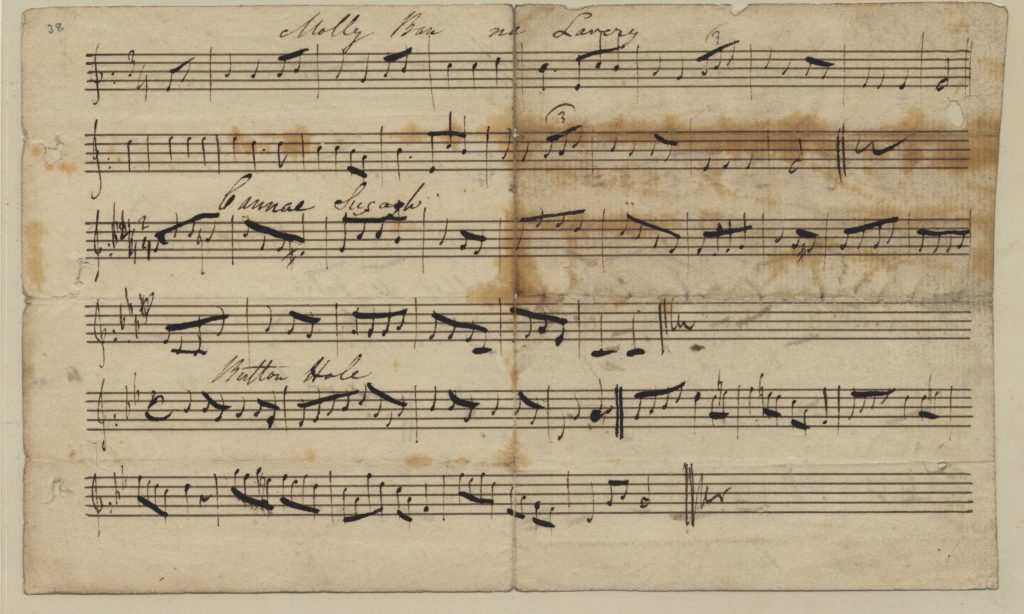
The title of Molly Ban na Lavery connects us with the ballad tradition (see below).
Other tunes with related titles
Pádraigín Ní Uallacháin lists variant titles in her book A Hidden Ulster (Four Courts, Dublin, 2003, no.30, p.206), including Neillí Bhán; Molaí Bheag; Máire Bhán; Máire Bheag; and Malaidh Bhán. This gives us some idea of the range of titles that we might be looking for.
Edward Bunting has other tunes or tune fragments titled “Molly Vann” or similar. I haven’t paid that much attention to them since they seem less connected, but perhaps I should go through them more systematically at some point.
There is a dots transcription of a tune titled “Molly Vann” (or “Vaun”) in QUB SC MS4.33.2 p.95. This page includes dots transcriptions of other tunes and may represent a page of live transcriptions from a harper. I need to work on this page.
Scribbled onto the front endpaper (now page 11) of QUB SC MS4.33.2 is the pencil note “don’t forget / Molly Bann”, and a fragment of a neat copy of a tune. I don’t know how this fragment of melody fits in, or when it might date to.
There is a tag in MS4.12.2.25 saying something like “Molly Vann for preface” so I wonder if this is connected to Bunting wanting to use Mailí Bhán as some kind of illustrative tune? And maybe connected to the “Examples” sheet as well?
On p.56 of the 1809 print, is a tune “Mairgireud Bhan – Peggy Ban”. Donal O’Sullivan says that he can’t find any words to it, but that seems disingenuous given his eagerness to combine words and tunes elsewhere. He identifies a neat tune in James Cody’s manuscript (QUB SC MS4.33.4 p29) titled “Peggy bán” as Bunting’s source for the tune. Bunting’s annotation in his copy of the printed book reads “Harp Hempson / very ancient” but I haven’t found any harp transcription that might be what Denis O’Hampsey played. I am thinking there might be a connection between this tune and the otherwise unidentified tune “Brullagh baun – a fine chest (or breast)” in QUB SC MS4.29 p.125, apparently collected by Bunting from a singer in Mayo in the summer of 1792 (unless I am misunderstanding this section of the manuscript, and this is the O’Hampsey transcription? I added a note to my tune list spreadsheet)
Another otherwise unidentified “Molly” tune from Bunting’s summer 1792 trip to Mayo is the dots transcription of “Ta gradh agam ar Warre / Dear Molly I love you” on QUB SC MS4.29 p.239. This seems to have echoes of our Mailí Bhán tunes as well.
The very next tune in the 1809 print to Quin’s Mailí Bhán is “Maille Dheas Bhan – The Beauteous Fair Molly”. This tune was transcribed by Edward Bunting from a singer in Westport in the summer of 1802; the tune is in QUB SC MS4.33.1 p.24. The page is headed “Redmond Staunton” but according to the index of MS4.7 the words were collected by Patrick Lynch from John McDermud, and so we may wonder if Bunting’s Redmond Staunton tag only refers to the first item on this page, which is information about a different song. Lynch’s neat copy of the words, beginning “Déanfad mo theach ar an árd”, is in QUB MS4.7.229, and his English translation is QUB SC MS4.32.060. As I keep saying, someone needs to collate the tunes and texts collected by Bunting and Lynch in 1802. I don’t think this tune or song are connected to our Mailí Bhán.
I am sure there are loads more tunes titled “Mailí Bhán” or similar in the wider tradition but that will do for now, we are getting distracted.
English-language song
In her book Secrets of the Gaelic Harp, Ann Heymann says (p.50):
A great many songs concerning Molly Bawn (“Fair Molly”) have been collected, most of which involve her accidental shooting by a true lover who spies her white apron while hunting and mistakes it for a swan
I have only recently started chasing these songs. There is a very interesting article by Jennifer J O’Connor, ‘The Irish Origins and Variations of the Ballad “Molly Brown”’, Canadian Journal for Traditional Music vol 14, 1986. O’Connor gives two variants of the text, and a discussion about the variant versions of this song. She concludes that although the theme of the swan-maiden being shot through mistaken identity is an ancient and universal theme, the are specific features of this song that enable it to be given a date and place of origin. The naming of the protagonists, Molley Bann Lavery and James Reynolds, from Kilwarlin, Co. Down, gives us a place as well as a social context; O’Connor cites Shiels suggesting Reynolds was Protestant and Lavery Catholic. Kilwarlin is between Moira and Hillsborough, just south of the M1 motorway between junctions 8 and 9.
O’Connor suggests that the song might date to the seventeenth century, though it is perhaps more likely that it is eighteenth century in date in the form we have it now. O’Connor cites a prose description of the ballad from 1799.
O’Connor says that there are many many written and recorded versions of this song, from Ireland, Britain and the Americas. I presume from the early references, that the song went to Britain and America and Canada with the Irish disapora in the 18th century. I have tracked down a few interesting examples.
You can listen to a recording of Eula Maxfield Garrott, in Arkansas, USA, singing the song in 1952. Garrott’s text begins “I took my gun one evening, a hunting for a swan”.
In Colm Ó Lochlainn’s book Irish Street Ballads (Three Candles, 1939) he gives as song 29 “Young Molly Bán”, which begins “Come all you young fellows that follow the gun”, and he gives the tune as well.
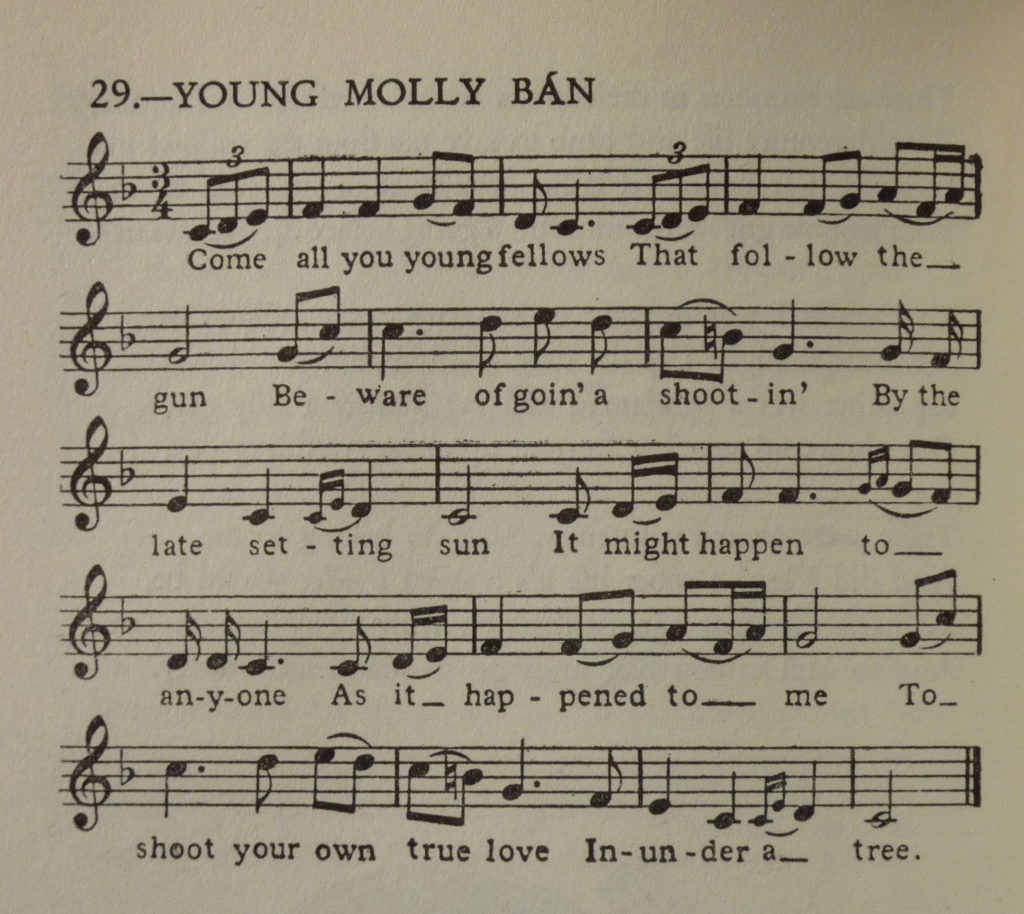
Ó Lochlainn says in his “Commentary” (p.211) that he learned the song from the singing of P. Walsh, Clogher Valley. He also gives references to other versions, including one from P.W. Joyce, Old Irish Folk Music (Dublin 1909) No.409, p.220. Note that in Joyce’s text, she is mistaken for a fawn, not a swan.
My header image shows the woodcut used by Ó Lochlainn to illustrate this song.
Scottish Gaelic song
O’Connor refers to a Scottish Gaelic song, A Mhairead Og, sung by Flora MacNeil. MacNeil’s text begins “A Mhairead òg, ‘s tu rinn mo leòn, ‘s e caileag bhòidheach, lurach thu”. There’s a full set of lyrics and translation, and a performance by Julie Fowlis here on Songs of the Isles. Her title is A Chatriona Òg, and her version starts “A Chatrion’ òg ‘s tu rinn mo leòn, ‘s tu dh’fhàg fo bhròn ‘s fo mhulad mi”.
Irish-language song
Perhaps I just haven’t explored enough, but I haven’t found an Irish-language song referring to the mistaken shooting. But there are Irish love-songs which may be related to our tune or title.
Pádraigín Ní Uallacháin published an edited song text with a melody notated in sol-fa, in her book A Hidden Ulster (Four Courts, Dublin, 2003, no.30,p.204-6). The song begins “A Mháire bhán na gcarad is a Mháire bhán, a stór”. Ní Uallacháin says “This was clearly one of the most popular love songs in the southeast Ulster region from the many similar versions which were collected locally”. You can listen to Siubhán Ní Chonchubhair singing this version of the song, on Pádraigín Ní Uallacháin’s Oriel Arts website. The website also gives the text and translation, and two variant versions of the melody, as well as a more detailed commentary than what was published in the book.
On the Oriel Arts website, Ní Uallacháin mentions a 1931 recording of “Mrs Kitty McGivern, Caithtí Bean Mhic Ghuibhrín who lived in Ballinteskin and [was] born c.1853”. The recording was made by Karl Tempel in Belfast, for William Doegen, and you can listen online at the RIA Doegen Project. In the recording of “A Neilí bháin, a théagar”, Cáit Ní Ghuibhirín sings the first line only, and then recites the rest of the song, because Tempel and Doegen were linguists interested in spoken dialect, and were not really interested in the music. Cáit Ní Ghuibhirín’s text begins “A Neilí bhán, a théagar, agus a Neilí bhán a stór”.
in Secrets p.50, Ann Heymann printed an Irish language song text, beginning “A Mhailí bhán, O, fuair tú náire! ‘Se deir na leagha liom gur rug tú clann”, with an “English translation by Donal O’Sullivan”. Donal O’Sullivan had printed this text and translation in his editions of Bunting’s tunes, ‘The Bunting Collection of Irish Folk Music and Songs, Part IV’, Journal of the Irish Folk Song Society, London Vol XXVI for December 1929, published in 1932, p.97-98, as song no.87, “Mailí Bhán”.
O’Sullivan was working through Bunting’s printed piano books, one tune at a time, and for each of the printed piano arrangements he tried to find a manuscript version of the tune, and he also tried to find song lyrics that somehow matched the tune. He did amazing work considering the resources available to him, and the overwhelming size of the manuscript collections; but he was uncritical in his assessment of the different manuscripts and he often was over-eager to match lyrics to tunes or even to change titles in some cases.
In this case, O’Sullivan found the manuscript copy of the tune in Bunting’s 1802 notebook, in the section written upside-down at the back which Bunting seems to have taken as live transcriptions from the playing of harper, Patrick Quin, in County Armagh (see above). However, O’Sullivan didn’t realise about the Quin provenance of this group of tunes, and he says (p.98) “Bunting does not state from whom he obtained this air”.
O’Sullivan printed Quin’s harp tune, underlaid with the text beginning “A Mhailí bhán, O, fuair tú náire”, and says that the words were “noted by Lynch from John MacDermud, Castlebar”. O’Sullivan says nothing more about why he chooses to marry this tune and these lyrics – the only implied reason is that both are in the “Bunting Manuscripts” and both are titled “Mailí Bhán”.
We instantly see deep unexamined assumptions here. Firstly, that the old Irish song tradition was a coherent whole, so that titles and tunes and lyrics could be slotted together like pieces of a jigsaw puzzle. But the riot of variants and unrelated versions listed above shows this is hopelessly naive. Secondly, that the Bunting Manuscripts are a coherent whole. Yet this also is obviously not true. Edward Bunting transcribed the tune from the harp playing of Patrick Quin in county Armagh. John Lynch transcribed the text of this song from the singer John MacDermud in county Mayo. Neither Bunting nor Lynch made any connection between each other’s tune or text.
We can read Lynch’s account of the collecting of these lyrics in his Journal (Queen’s University Belfast, Special Collections MS4.24 p.7-8). On Sunday 23rd May 1802, Lynch tells us (p.7) “I went to the house of John McDermud a shoemaker where as I had been told I might have a room and bed – he had none to let – I told my business – he promised to assist me”. The next day (p.8) “Monday evening about 9 o clock I treated McDermot to beer in John McVeilys”. Lynch tells us how McVeily the pub landlord, sang a song, and also told Lynch the names of other singers.
Later in his Journal, Lynch includes a kind of index, where he lists the names of singers and the songs he collected from them. On page 48, we see that John McDermud is listed as the source of a number of songs, including “tra ghluaisios si Mailigh”, “Mailig Bhan”, and “Mailig Dheas Bhán ni Cuileanan”.
We also see that J. Duffy, a mason in Castlebar, is the source for a song “Gearradh Gaid”. Donal O’Sullivan printed this song as a kind of appendix to his printing of Mailí Bhán, making it no.87a on p.99 of his ‘Part III’. He says (p.100) “it is in the same metre… and can therefore be sung to the same tune… both may have been part of the same song”. He points out that Lynch’s earliest version, perhaps a live transcription, is in the back of the Journal manuscript (p.76), where it is titled “Gearra Gaid no Mailigh Bhan”. To me, this highlights the arbitrariness of O’Sullivan’s work, and the way in which his personal choices or aesthetic opinions have affected understanding of the tradition down to the present day. Why did he prioritise the MacDermot lyric beginning “A Mhailí bhán, O, fuair tú náire”, over the Duffy lyric beginning “Shaoil mé, a stóir ghil, go roibh tú ró-cheart”?
There are a number of neat presentation manuscripts made by Lynch which are preserved in Edward Bunting’s papers in Queen’s University Belfast MS4. We can see Lynch’s neat copy of Gearradh Gaid / Mailí Bhán, “Shaoil mé, a stóir ghil, go roibh tú ró-cheart” in MS4.7 p.234 (no.161) and we can see his neat copy of Mailí Bhán, “A Mhailí bhán, O, fuair tú náire” in MS4.7.132 (no.85).
It is worth emphasising that for all of this information about the two sets of lyrics collected by Lynch in Castlebar, we have no information whatsoever about what tunes were used to sing these lyrics. I have had a cursory search through Bunting’s 1802 transcription notebooks and so far I am not seeing any tune that is a candidate for having been transcribed from the Castlebar singers for either of these two songs.
Conclusion
I regret now that I uncritically followed Donal O’Sullivan in matching John McDermot’s text “A Mhailí bhán, O, fuair tú náire” to Quin’s tune in my harp classes, and in the first two editions of my book Progressive Lessons. By the time I was working on the 3rd revised edition, I knew that I no longer believed in this match, but I did not have anything better to suggest, and so I presented just the instrumental set and said nothing about any associated song. It seems clear that it was a misguided error to claim the lyric “A Mhailí bhán, O, fuair tú náire” as an integral part of the harp tradition.
I think that it is clear that we have the live transcriptions of Quin’s playing, upside-down at the back of QUB SC MS4.33.1; but we have no information about him singing, or about the use of song in the teaching of the three “first tunes” which he gave to Bunting.
It seems to me that the title and the melody of the instrumental harp tune “Mailí Bhán” which Quin played on the harp for Edward Bunting, is associated in a general way with a whole world of variant tunes, and texts in both Irish and English. I presume that these tunes and texts would be known in the wider tradition, before a harper started being taught the fingerings and techniques to learn to play the particular instrumental set of Mailí Bhán being used for instruction. Some of them, including the Oriel Irish-language song, and the English-language ballad, are situated geographically close to where Patrick Quin was active, and so it is sensible to assume he, and his teachers, and his student, may have been familiar with them.
Irish and English
I have been reading Aidan Doyle’s book, A history of the Irish language (Oxford, 2015). Doyle tries to lay out evidence for the interaction between the Irish and English languages and how the two languages co-existed in Ireland “from the Norman Invasion to Independence”. (I think he stopped the book in 1922 so as to be able to avoid more recent political questions!)
One of Doyle’s main points is the way that bilingualism (people able to speak and understand both languages), and diglossia (the use of different languages in different social contexts) were the norm for much of this time across much of the country.
Doyle is also interested in the mismatch between perceptions and reality, and talks a lot about the beginning of the revival of the Irish language in the late 1800s, the creation of myths and narratives which still have resonance today.
I think that if we label our music as the “Gaelic harp” tradition we presume or imply that the old Irish and Scottish harp traditions were monolingual. But I think it is much more likely that there was significant amounts of English language contents and context in the old Irish harp traditions, just as there were in Scotland.
The English-language ballads about Mailí Bhán, rooted in the south-east county Down landscape and communities, might be a good reminder to us. Some versions of the song even display a fragment of that bi-lingual aspect, as cited by O’Connor. Louis Boutilier in Tantallon, Nova Scotia, sang this version in August 1950, beginning “As Jimmie went a-hunting, with his dog and his gun”. The girl’s name is given as Molly Laura (a corruption of Lavery perhaps?), and in the 9th verse, Jimmie addresses the dead Molly:
A muise, chuisle, mo mhuirnín,
O, is chuisle mo chroí
if you were a-living
it is married we would be
You can download the entire song here. Thanks to Pádraigín Ní Uallacháin for helping me understand Boutilier’s Irish lines.
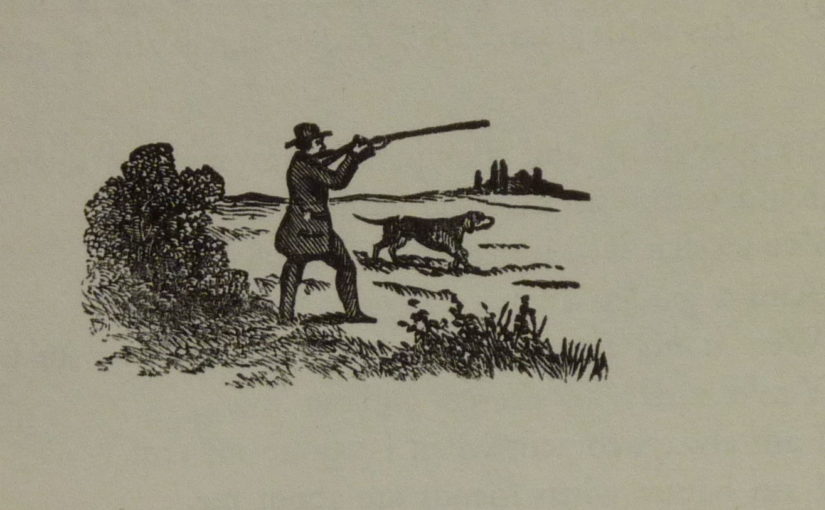
Thanks to Ann and Charlie Heymann for sending me a couple of missing references in MS4.12. I have updated the section on Quin’s Mailí Bhán to take these into consideration.
Bess Cronin had a lovely minor-mode tune for the English-language ballad. You can listen on the CD included in her book: The songs of Elizabeth Cronin, edited by Dáibhí Ó Cróinín, song 92, p.151-3, CD 2 track 26. The commentary includes some variant texts and some useful references to other versions from England.
Siobhán Armstrong spotted another variant set of words that seems related to John McDermud’s lyrics. This set of words is no.51 in Dhá Chéad de Cheoltaibh Uladh.
A Mhalaigh bhán dheas fuair tú an trácht sin,
Agus deir na mná liom go rabh tú ann
However, again there is no hint there of what tune they might sing to.
Another song worth looking at is Pretty Molly, the Gosport ballad, which tells a story set in 1726, a few miles across the water from where I grew up.
The version sung by Charlie Somers from Magilligan, is no.52 in Hugh Shields’s Shamrock, Rose and Thistle.
Here’s a great recording of the English-language ballad, sung in 1988 by Michael McGonigle:
https://www.itma.ie/digital-library/sound/molly_bawn_michael_mcgonigle
I made PDF typeset versions and machine audio of the notations shown on this page. Usually I prefer not to edit my posts, but in this case I thought it made sense to insert the audio and PDF links directly beneath the relevant notations.
Sylvia Crawford has made a demonstration video of Mailí Bhán based on the harp transcription from Patrick Quin (QUB SC MS4.33.1 p.71-2.
I went to Kilwarlin, and walked the road between the Moravian church and the junction with Lavery’s Bridge Road. I met a local woman on the road and had an interesting conversation about the area.
The Moravian church is very lovely, having been originally built in 1755, though this seems probably to have been after Mailí’s time.
I found a very interesting thread on Mudcat about the ballad song of Mailí Bhán, which includes some useful references, including a wonderful recording of Molly Jackson in 1930.